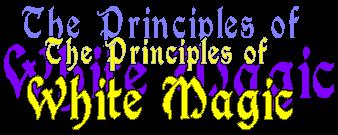An Essay on

©
2008 by Academic Services International, Los Lunas, NM, USA
![]()
.
Chapter 4
The Dynamics
Now it is time to put it all together in a sequential manner. This chapter examines the various stages of a complete ritual in the order that each should be performed.
The Seven Stages of any ceremony include Preparation, Opening, Banishing, The Oath, Invocation, Evocation, and Closing.
The Labor of Preparation
Preparation is a magical power unto itself and is technically called The Labor of Preparation. It includes Determination, Correlation and Preparation. It also includes a lot of hard work.
Determination is when one determines just exactly what they intend to accomplish. If it is just a question of practicing, then a simple schedule can be established wherein the various rituals (Banishing, Invocation, etc.) are repeated on a regular basis. Let there be no mistake here, there needs to be a lot of routine practice.
If it be a matter of celebration, perhaps a Solstice or an Equinox, then the astrological calendar may be consulted.
If it be an undertaking to obtain esoteric information or to expand one's consciousness, then this would be similar to routine practice, but one does need to decide beforehand the exact nature of the objective.
However, if there is to be a special rite conducted for the purpose of advancing the evolutionary process, then one simply doesn't step in and change the course of destiny. Like a good soldier, who only acts after receiving orders from a superior officer, the original concept or impulse must come from some realm of higher consciousness.
The magician must first attain to The Vision, that is, an overview of what is intended by the planetary hierarchy as the goal for humanity. Then he or she must gain access to The Plan, which is the method for obtaining that goal. Of course, a practitioner might simply receive instructions from the Secret Chiefs, or the Solar Angel (and this is always a primary source of inspiration). But if you were to decide to change things just because you don't like a particular politician and rush out to influence the outcome of an election? Well, sorry, but that sounds a bit like Black Magic.
In any case, you first get the idea from on high. Then you proceed to organize matters and make plans.
Correlation is that process discussed earlier under Integration of the Elements. It involves consulting (memorized?) Tables of Correspondences and selecting the arrangement and the instruments that conform to the goal.
Preparation is where one's mind is put to work and the hands often get dirty. The chosen instruments must be polished, and the arrangement of the temple, the numbers, the colors, and the incense must be laid out. At this point, there are usually magical scavenger hunts conducted that take the magician into the outer world in order to find and obtain some obscure item.
Then the circle must be drawn and the instruments must be gathered and placed in their appropriate positions within its circumference. Newly obtained items must be ceremonially purified and consecrated, and this process may well constitute one or more separate rites, conducted in advance of the actual ritual itself.
The date and time of the ceremony will, of course, be astrologically selected. It is not unusual for the entire labor of preparation to consume weeks, months, and even years. Prior to the rite, the participants will bathe, groom, and perhaps adorn with a (consecrated) scent befitting the nature of the ritual. Finally, everything is in its place and there inevitably comes the hour of commencement.
The following discussion describes the elements of a generic ceremony. Examples of specific rituals are found in the Appendix.
The Grand Opening
Opening is the process of starting the ceremony. The magus, and any assistants, are properly robed and armed. The telephone is disconnected, the door is locked, the personnel enter the circle, the background incense sticks are lit. If an evocation is to be performed (an entirely optional event), the three corners of the triangle are activated with fire (or perhaps this is belated - see evocation, below), and a period of meditation ensues.
At the appointed time, the magus steps up to the altar, faces east (other directions may apply in certain rites), raises the bell and strikes the battery.
The battery is the number and sequence of the tones struck upon the bell. The striking must not be rushed - each set of tones should radiate out to silent infinity. In general openings, 3-5-3 is appropriate, for eleven is the number of magic.
! ! ! - ! ! ! ! ! - ! ! !
The Banishing
The magus replaces the bell and takes up the Dagger. A Banishing Ritual is then performed. Note that most clearing rites consist of four stages: a preliminary centering, followed by a dynamic projection of the pentagram out into the four quarters, succeeded by a declaration of having cleared the circle, and concluded with a final centering. Only the first three stages should be carried out at this point - the final centering being part of the Closing that comes at the far end of the ceremony.
Upon completing the declaration of the cleared circle, the magus will set aside the dagger and proceed to kindle the fire in the censer, taking time to ensure that any coals are indeed properly ignited, for there is a tendency at this point for the phlogiston to expire and render the inferno extinct.
The Oath
The magus will now proceed to recite the Oath, which is a magical affirmation that states the intent of the ceremony accompanied by a vow to indeed follow through to its accomplishment.
.
.